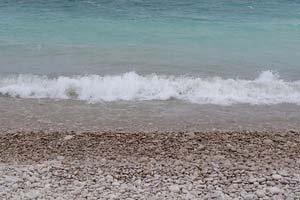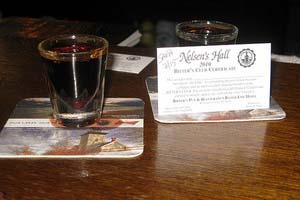An acrid smell wafts up from the shot glass brimming with brown liquid, and my nose wrinkles slightly. “You like Old-Fashioneds,” I encourage myself silently, “and bitters are used in those.” All eyes are on me as I pick up the shot glass, throw back my head and toss the bitter liquid down. Without making a sound, I quickly gulp the beer chaser proffered, then set both glasses down with a grin. The table erupts in applause.
“Congratulations,” says our waitress, dunking my thumb in some more bitters, then gently rolling it onto a small card proclaiming me an official member of the Nelsen’s Hall Bitters Club. “You are now a true islander.”
Nelsen’s Hall, a 103-year-old tavern on tiny Washington Island, Wis., serves more bitters than any other spot in the world, and they’ve got a giant silver trophy from the Angostura company of Trinidad to prove it. Yet most of the two million visitors who annually flock to Wisconsin’s famed Door County, which includes Washington Island, don’t know about the Bitters Club because they stay on the glitzy peninsula, with its chic boutiques and art galleries.
Those brave enough to ferry across Death’s Door to Washington Island, though, never regret it.
Washington Island was settled in the mid-1800s by Icelanders attracted to its rockbound coastlines and cool, windy climate, which reminded them of home. These settlers formed America’s first Icelandic community and attracted other immigrants, primarily Swedes, Norwegians, Danes and Finns, who helped transform the island into a bustling fishing, farming and logging community.
The town is fiercely proud of its Scandinavian heritage, and it shows, from the flags of its ancestors’ countries that proudly flap in the harbor breeze to the volunteers who worked for years to construct an authentic stavkirke, or Norwegian stave church, to honor their forefathers’ faith. To get the most out of your visit, I realize you must pay homage to this ancestry.
Wiping a drop of bitters from my chin, I start by visiting the stave church, which dramatically blends Viking ship elements with traditional church architecture. The exterior is stern and imposing, with dark wooden siding and shingles. Four dragon heads at the “prows” of its the gabled roof make trespassers think twice. The interior, though, is light and bright and still smells of freshly cut wood, several years after its completion.
At nearby Field Wood Farm, I admire the rare Icelandic horses available for rides. The small horses are stocky and exceptionally strong, yet quite docile. As owner Laurie Veness gets ready to take a group on a ride, her feet not that far off the ground, she notes the horses have five, not four, different gaits, and are known for their silky smooth transport, where you can ride a trot like a canter.
Vaness is the sister-in-law of John Herschberger, head of the stavkirke project, says “Red Ed” Livingston, a local tour operator, noting the community of 680 is close-knit. “If you start looking back on your family tree, pretty soon you find out you’re your own grandfather,” he laughs.
Livingston steers me to Schoolhouse Beach, a source of local pride. The beach is incredible – no sand, just mounds and mounds of white limestone rocks, tumbled to a satiny sheen from years of gently rubbing against each other as the waves washed in and out of the harbor. I’m tempted to slip a few in my pocket, but don’t; there’s a stiff fine for smooth-stone-stealing. The beach was once piled several times as high with stones, but visitors’ and residents’ sticky fingers eventually depleted the supply, hence the fine.
Another friendly local points me to the small ferry heading to neighboring Rock Island, so I climb aboard. Rock Island is a state park, and home to the ghostly remains of Icelander Chester Thoradson’s grand estate. Thoradson, a millionaire investor, constructed his estate from the area’s ubiquitous rocks, some say with financial aid from famed gangster Al Capone; Rock Island was a transfer point for bootleg whiskey going from Capone to Detroit’s Purple gang. Several of the impressive stone buildings that remain are on the National Register of Historic Places, including an immense, dank boathouse, whose cavernous upper hall features Thoradson’s massive Icelandic carved oak furniture, a treat not to be missed.
Pottawatomi Light, Wisconsin’s oldest lighthouse, is also on this island. A scenic hike to the restored 1836 structure nets me passage to the lantern housing, where I’m overpowered by a strong, unpleasant odor. Bat urine, the young ranger on duty says with a grin. Luckily, the phenomenal view of Lake Michigan makes up for the smell.
Back on Washington Island, I try to complete my Scandinavian pilgrimage with a stay at the Inn at Froghollow Farm, a restored Norwegian farmhouse built in 1892. It’s full, so I end up in a rustic, knotty pine room at the aging-but-clean Dor Cros Inn, where owner Cory Anders lights a big bonfire for guests to enjoy.
Relaxed, I contemplate having another shot of bitters. And what do shots of bitters have to do with Scandinavia? Not much, actually. The Bitters Club got started during Prohibition, when Danish saloon owner Tom Nelsen obtained his pharmacist’s license so he could legally dispense the 90-proof liquid, normally used for stomachaches. A tradition was born, with Nelsen personally downing a pint a day. A second shot should do it for me.



